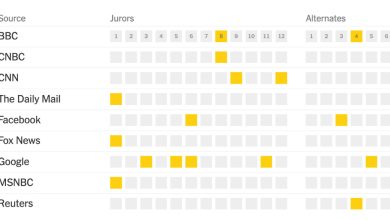Who’s Afraid of Integration? A Lot of People, Actually.

In 1999, Robert D. Potter, a federal judge who was a protégé of Senator Jesse Helms, Republican of North Carolina, ordered the Charlotte-Mecklenburg school district to abandon the busing-for-desegregation program that had integrated its public school system for three decades. Potter declared that the school district had “eliminated, to the extent practicable, the vestiges of past discrimination in the traditional areas of school operations.”
In fact, when Potter’s order was carried out in the summer of 2002, both Black and white students were abruptly transferred from integrated schools to neighborhood schools with much higher levels of segregation. His ruling set in motion what social scientists call a natural experiment — the opportunity to determine who wins and who loses in response to changes in public policy — and what the consequences are.
Three economists, Stephen Billings of the University of Colorado, David Deming of the Kennedy School at Harvard and Jonah Rockoff of Columbia Business School, tapped into a gold mine of data in 2012 to write “School Segregation, Educational Attainment and Crime: Evidence From the End of Busing in Charlotte-Mecklenburg.”
What did they find?
First, they wrote that “the resegregation of schools widened inequality of outcomes between whites and minorities. We estimate that all students, white and Black, score lower on high school exams when they attend schools with more minority students.” Moreover, “a 10-percentage-point increase in the share of minorities in a student’s assigned school decreases high school test scores by about 0.014 standard deviations.”
Billings, Deming and Rockoff wrote that white students were “less likely to graduate from high school or attend a four-year college when they are assigned to schools with more minority students,” but “given the increase in same-race segregation, this implies that white students had higher graduation and attendance rates after the policy change.”
What about crime rates?
“The rezoning of Charlotte-Mecklenburg schools led to statistically significant and large increases in crime among minority males,” they wrote. The increases in crime, according to the authors, “are driven entirely by poor minority males who are assigned to schools with higher shares of poor minority students.”
Billings, the lead author of the paper, has written extensively about the complex, often unintended, consequences of policy initiatives governing school suspensions (“Proving the School-to-Prison Pipeline”), failing schools (“Gentrification and Failing Schools: The Unintended Consequences of School Choice Under No Child Left Behind”) and lottery-based school choice (“Does School Choice Increase Crime?”).
I asked Billings to assess the conclusions he has drawn over the decade since the original paper appeared.
He replied by email:
Policies that do address poverty and racial inequality, Billings continued, “often involve taking resources away from wealthier and typically white families that has led to some resentment among those groups and fueled popularity” for such politicians as Donald Trump and Ron DeSantis.
In summary, Billings wrote,
The issues raised by the abandonment of busing for desegregation in Charlotte-Mecklenburg clearly resonate in the politics of 2023, but there is surprisingly little data to determine where things stand.
I asked Ashley Jardina, a political scientist at George Mason University and the author of “White Identity Politics,” the following question:
Jardina replied by email that “work on the racial composition of schools and performance outcomes is really outside of my wheelhouse” but “what is interesting is that on the public opinion side, we also just haven’t even asked white Americans their opinion on issues like busing, school integration and neighborhood diversity on our national public opinion surveys in decades. It’s almost as if the social sciences have assumed that public opinion on these matters has been settled.”
In fact, Jardina continued, “I suspect that school choice and neighborhood composition is where the rubber meets the road for many liberal white Americans who simultaneously consider themselves to be racially progressive and support many policies that would promote racial equality, except for those that might threaten their own house values or local public schools’ test scores.”
In fact, both white and Black views on the deeply divisive issues of achievement gaps, school discipline and promotion requirements are difficult matters to explore.
Two illuminating newspaper articles on the school system in Shaker Heights, Ohio — an affluent suburb of Cleveland that has determinedly sought to be an exception to the nearly universal history of white flight — were reported and written by Laura Meckler in The Washington Post and Debra Kamin in The Times.
In October 2019, Meckler, a graduate of Shaker Heights schools, published “This Trailblazing Suburb Has Tried for 60 Years to Tackle Race. What if Trying Isn’t Enough?”
In the 1950s, Meckler wrote, when white people in other communities fled as Black families began to move in, “in Shaker, white families knocked on doors and got to know their new neighbors.”
Shaker Heights, founded as a wealthy and white enclave of privilege, she continued,
But, Meckler cautioned, racial tensions began to mount nearly three decades ago and have continued to play a central role.
“By the mid-1990s,” she wrote, “integration was well established in Shaker Heights, but so was an unsettling racial achievement gap the district wasn’t talking about. Then came Project Achieve, a biracial committee of parents, teachers and community members formed to dissect the district.”
The committee issued its report in March 1997, noting that
Once the report became public, “Black students and parents became furious. Some felt they were being painted as academic losers,” Meckler wrote, describing the emergence of anger and resentment that became commonplace in community meetings.
The Times published Kamin’s article “Could Black Flight Change a Model of Integration?” in January. She had found a new dynamic, the migration of Black families away from Shaker Heights:
“Shaker Heights was no longer a first choice for many Black families, and a creeping exodus of Black families to neighboring towns was beginning to take shape,” Kamin wrote. She added:
From 2010 to 2021, the Black share of the Shaker Heights population fell to 35.9 percent from 37.1 percent. Kamin noted that
In dozens of interviews, Kamin wrote,
Integration, in other words, is an exceptionally fraught process for both Black and white people, even in a liberal (2020 votes: 15,482 for Joe Biden, 1,965 for Trump), affluent (median household annual income: $92,463) suburb with relatively low crime rates (violent crime: 1.73 for every 1,000 residents, compared with 3.36 for all of Ohio).
I asked Ryan Enos, a political scientist at Harvard who has studied the complexities of interracial relations, the same question I posed to Jardina: If school and housing integration policies “improve employment prospects and increase the likelihood of marriage among minorities, why is there such intransigent opposition among white people?”
He replied by email that as the demographics of neighborhoods and communities change,
Enos pointed to Los Angeles, where
Why didn’t they segregate? Enos wrote:
He wrote that, on balance, “not only is integration good for minorities, it’s good for everybody because it can lead to more diverse neighborhoods, businesses and institutions, and the science on this is very clear: Diversity makes us smarter and richer.”
Why, then, is residential integration so hard to achieve?
Enos wrote:
Take the case, Enos wrote, “of an individual white homeowner when a community is integrating. Do they want to stay in that community to reap the long-term benefits of diversity when they might be worried about the short-term costs that come with the quality of their school or the price of their home?” He called this choice “the liberal dilemma, where things that liberals value collectively are not things that liberals are individually willing to pay the costs to achieve.”
From 2000 to 2020, there have been modest declines in the segregation levels between white and Black people and between white and Hispanic people.
William Frey, a demographer at the Brookings Institution, calculated the national rate of integration, using what is called a segregation index or dissimilarity index, which measures the extent to which two groups (such as white and Black populations) are unequally distributed across neighborhoods in a single metro area. The index ranges from zero (complete integration) to 100 (complete segregation).
The white-Black segregation index fell from 62 in 2000 to 59 in 2010 to 57 in 2020, Frey found. Over the same period, the white-Hispanic segregation index fell from 47 to 46 to 44.
In a separate 2021 study, “Neighborhood Segregation Persists for Black, Latino or Hispanic and Asian Americans,” Frey stressed that “white people still live in mostly white neighborhoods” where “longstanding patterns of segregation persist.” From 2015 to 2019, Frey noted, “the white population share in the neighborhood in which the average white person resides” was 71 percent in large metropolitan areas and was “even larger in smaller metropolitan areas and outside metropolitan areas: 79 percent and 85 percent white.”
Despite all the hurdles described above, there has been substantial progress in addressing racial inequities since the Supreme Court ordered an end to public school segregation in Brown v. Board of Education in 1954.
David Deming — an author of the article I mentioned at the beginning of this column — emailed me to say that “the story of American education over the last 30 years has been steady progress.”
More specifically, Deming pointed out that
In addition, the Black poverty rate fell from 41.8 percent in 1966 to 19.1 percent in 2021. From 1967 to 2021, annual Black per capita income, in inflation-adjusted dollars, grew from $9,971 to $28,648.
The share of law students of color in U.S. schools accredited by the American Bar Association was 11.23 percent in 1987; 20.57 percent in 2000 and 31.01 percent in 2019. In 2019, 13.4 percent of master’s degrees and 9.2 percent of Ph.D.s were awarded to African Americans. In 2021, according to the Census Bureau, 13.6 percent of the U.S. population was Black.
In other words, the overall picture is not bleak; there has been good news and bad news, and the good news signals impressive progress.
Despite those gains, Deming wrote that he is
In a 2017 essay, “Why Death Haunts Black Lives,” Douglas S. Massey, a sociologist at Princeton, addressed “the consequences of segregation,” arguing that
“A growing body of evidence,” Massey concluded,
Assuming Massey is right that segregation is the vehicle “through which Black poverty is transmitted and reproduced,” policymakers of good will face the enormous and perhaps insuperable task of restoring integration to center stage while somehow avoiding the political and logistical errors that characterized busing and affirmative action in the past.
Though there is light at the end of the tunnel, there are still miles to go.
The Times is committed to publishing a diversity of letters to the editor. We’d like to hear what you think about this or any of our articles. Here are some tips. And here’s our email: [email protected].
Follow The New York Times Opinion section on Facebook, Twitter (@NYTopinion) and Instagram.




